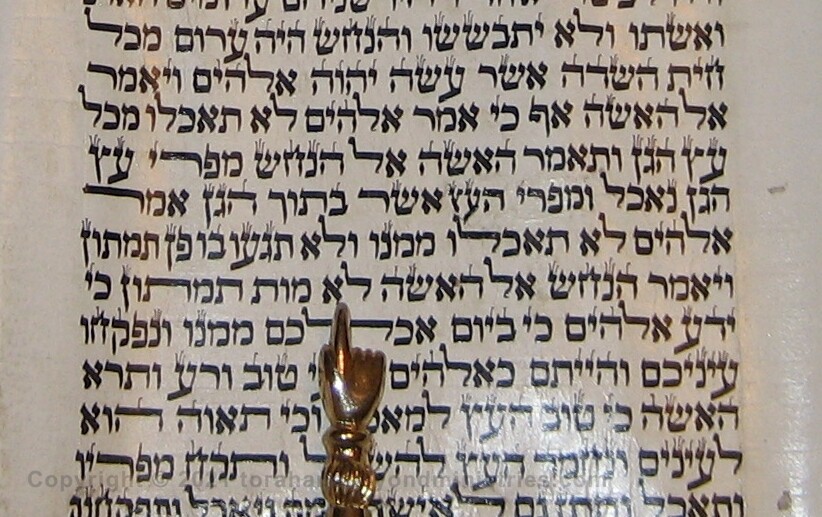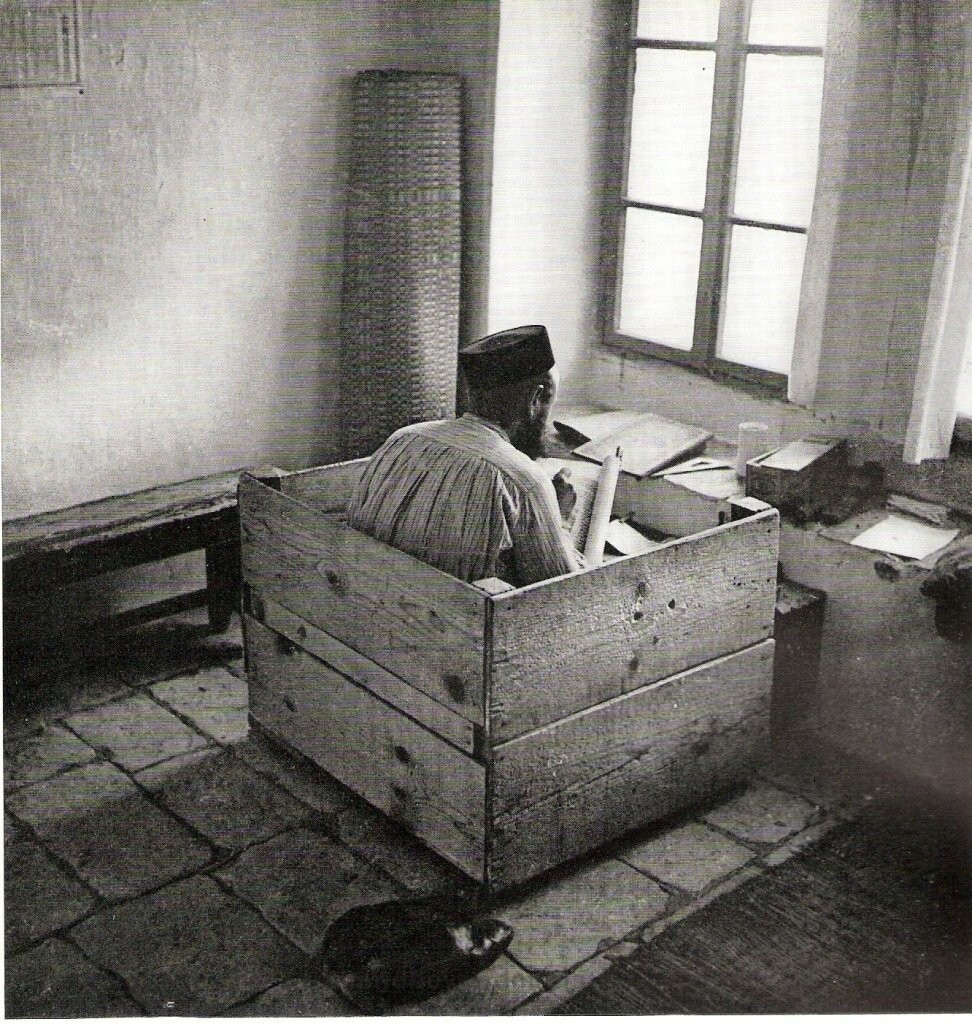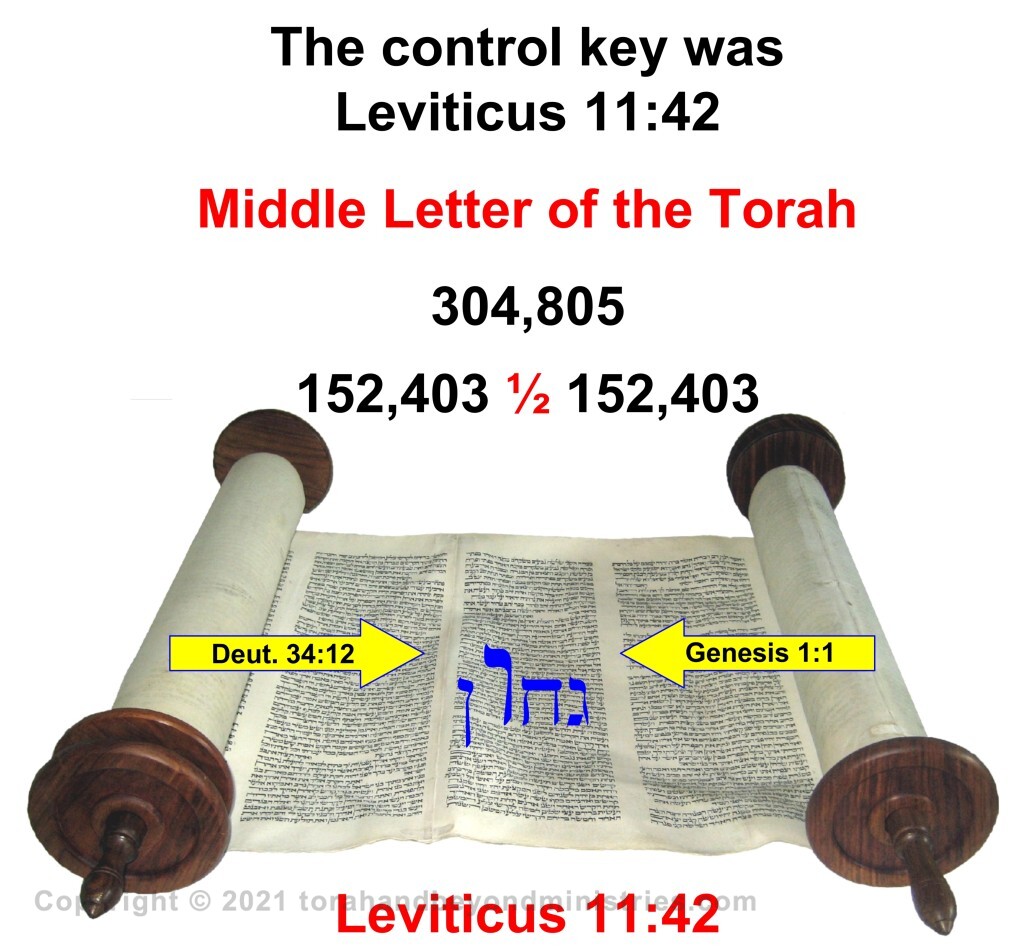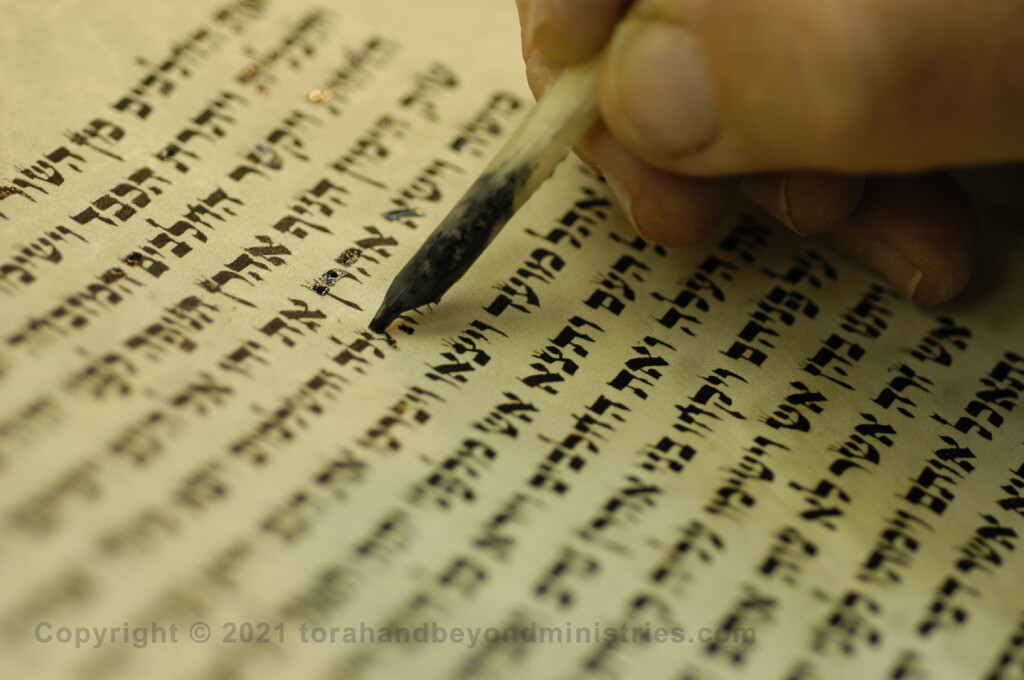
In the English language we commonly refer to the ones who write scrolls by the name “scribe”. In Hebrew, he is called a Sofer; literally “one who counts letters”.
From the beginning, in the Garden of Eden, to wicked King Jehudi, and on to the present day, the greatest effort has gone forth to change and destroy God’s Word.
Genesis 3:1-4 Now the serpent was more subtil than any beast of the field which the LORD God had made. And he said unto the woman, Yea, hath God said, Ye shall not eat of every tree of the garden? And the woman said unto the serpent, We may eat of the fruit of the trees of the garden: But of the fruit of the tree which is in the midst of the garden, God hath said, Ye shall not eat of it, neither shall ye touch it, lest ye die. And the serpent said unto the woman, Ye shall not surely die:
The following photograph is from a Torah Scroll written in Morocco in the early 20th century. The verses from Genesis 3:1-4 shows the first lie about the Word of God and how the Serpent changes what God had said.
God has chosen a special group of people to receive, record, and preserve His Word, the Hebrew Sofer, a counter of Letters.
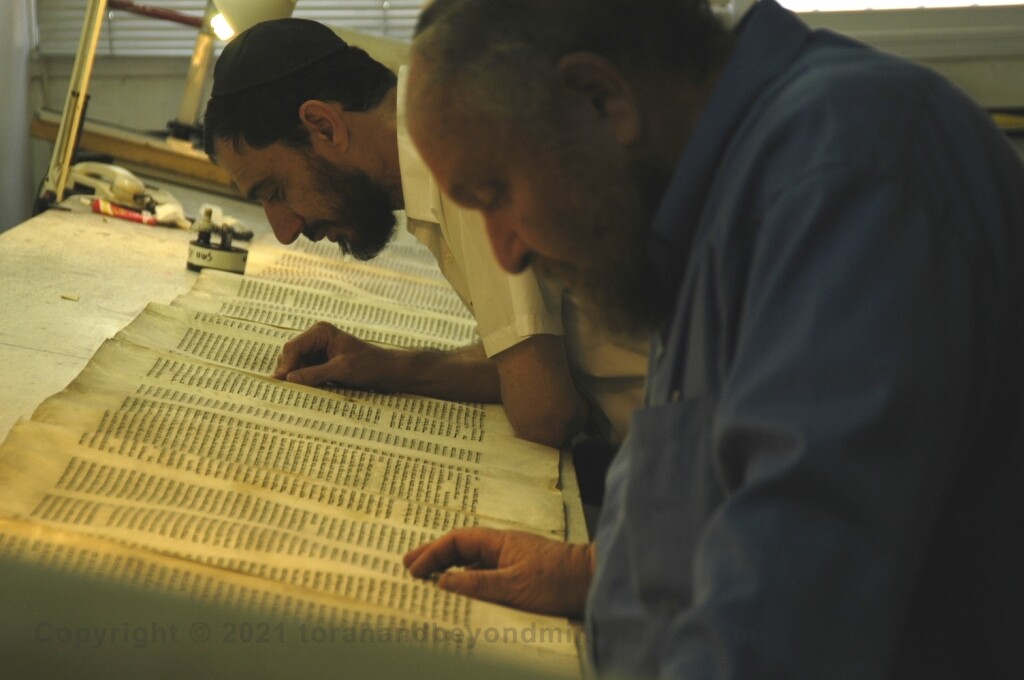
The Sefer Torah contains 304,805 Hebrew letters which have been copied countless times each century in Jewish communities throughout the world. By the Sofer’s meticulous work and tenacity to perfection they have kept the Torah, if copied according to the laws of STaM, virtually error free. With a world wide comparison of scrolls they are .00004 in world wide agreement with only six letters in question.
The writing of the Torah (Law), Neviim (Prophets), or Ketuvim (Writings) are not like any other writings. When the average person writes, they write quickly and from memory. The writing of a Sofer is slow and very deliberate.
Several centuries ago the laws of the Soferim, called STaM, were unified to give consistency in writing Sefri Torahs. It generally takes one year to write a Torah. On an average each Torah will have 245 columns with 42 lines each with a consistent total 304,805 letters.
A very rough estimate required for a Sofer’s time would be one sheet per week (average 52 sheets per Sefer Torah), one column per day, six lines per hour, and 3 letters per minute. The following quote is from Mordechai Pinchas Sofer STaM: “I average about 7-8 minutes a line and when I’m in the zone about 6 minutes and when struggling 10 minutes. So a good scribe should be able to do about 4 letters a minute. Sefardi scribes will be quicker. And careless scribes will be quicker still.”
This makes each letter valuable and if possible worthy of repair.
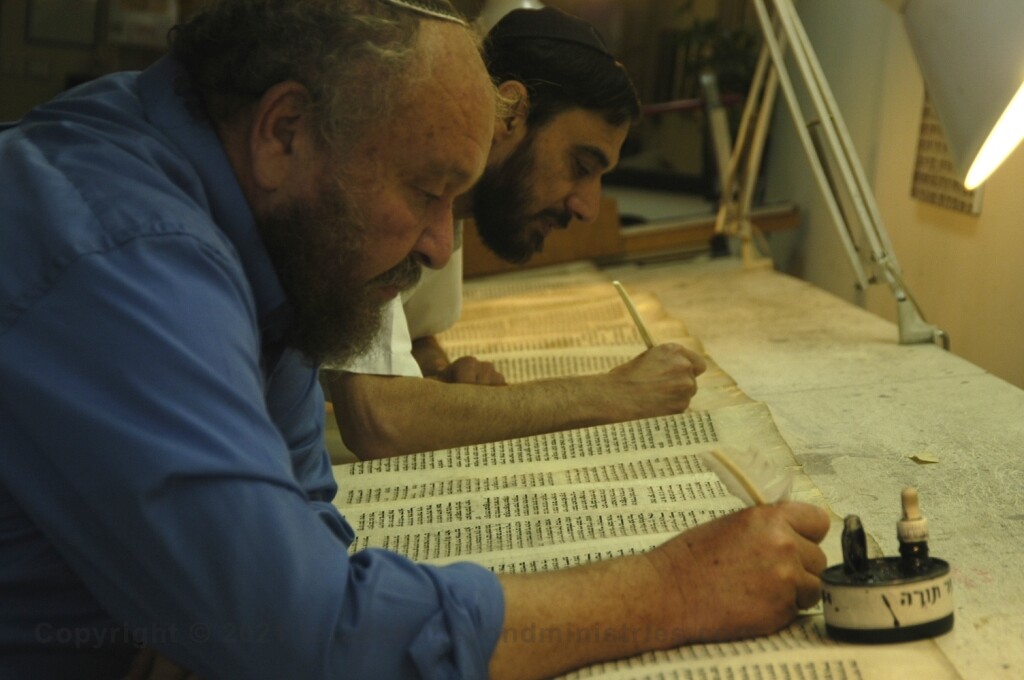
Almost all Biblical Hebrew manuscripts of any age show clear indication that hundreds if not thousands of letters or parts of letters have been repaired. The Soferim not only write the scrolls they repair them.
The following photograph was taken from a very old Torah Scroll. It shows thousands of letters that have been repaired many years ago and is now in need of re-lettering again. There must be a point that it is easier to write again the 304,805 letters of a New Torah Scroll rather than repairing the Scroll a second time.
As you enlarge this photograph you will clearly see the darker letters that have been repaired in the past compared to the lighter letters that have not been repaired. This portion of Scripture is from Numbers 16:22 through Numbers 17:5
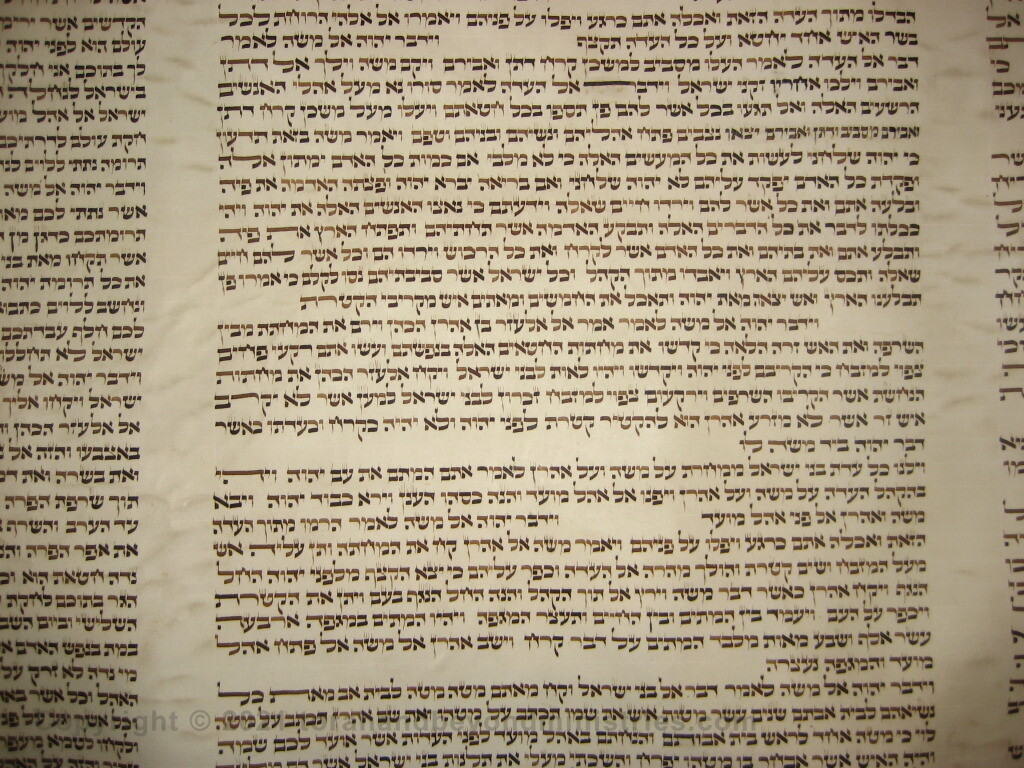
In most all articles about writing a Torah Scroll it is said that if only one of the 304,805 letters are not correct then the Scroll is not kosher, or fit to use and must be repaired before further use.
The Sofer must be trained and certified much in the same way as one working under the tutorship of a master craftsman. To be a Sofer is similar to being in a guild. There is a lot of training involved and to have the stamp of approval by an elder is highly coveted.
The qualifications of a Sofer are as follows:
A Sofer should be religiously observant, of good character, and knowledgeable about the laws concerning Sofrut. The calligraphy of writing STaM is not the hardest part of being a Sofer. The really hard part is remembering and observing the thousands of laws concerning writing Sefri Torahs, Neviim, Ketuvim, Phylacteries and Tfillin. There is constant rivalry and arguments among religious Jews as to interpreting the laws of STaM according to Halachic. Even the smallest detail may make an item pasul, non-kosher.
Someone may ask “are these scrolls real”. You cannot have a fake Torah. It is either done right or not at all. It is too cost prohibitive to do wrong. A “fake” Torah would be photocopy. These photo copied Torahs can be readily purchased for a few dollars from Jewish stores. A kosher Torah scroll will cost between $30,000 and $50,000 each.
The Ben Gurion Institute for Microfilming Hebrew Manuscripts in Jerusalem says that “if a manuscript is written according to the laws of STAM, the manuscript is considered to be original”. The scrolls I work with are considered “Original Hebrew Manuscripts”, not in the sense of the first one Moses wrote, but copies of that first Torah according to the laws of STaM. If anyone had the “original” Torah that Moses wrote it would be priceless. God has seen fit to leave the world without any originals not only in manuscripts, but also the Cross, the Brazen Serpent, etc. God does not want us to worship an object.
The word STaM is an acronym for the laws of writing Biblical Hebrew Manuscripts. The letters of STaM refer to the articles one is certified to write.
S – Sefer:
T – Tfillin:
M – Mezuzah
a – there are no vowels in Hebrew
S – Sefer rpo Scroll
A person who has been certified STaM is authorized to write Scrolls

T – Tfillin Nylypt – Phylacteries
Tfillin are a set of small black leather boxes containing scrolls of parchment inscribed with verses from the Torah.
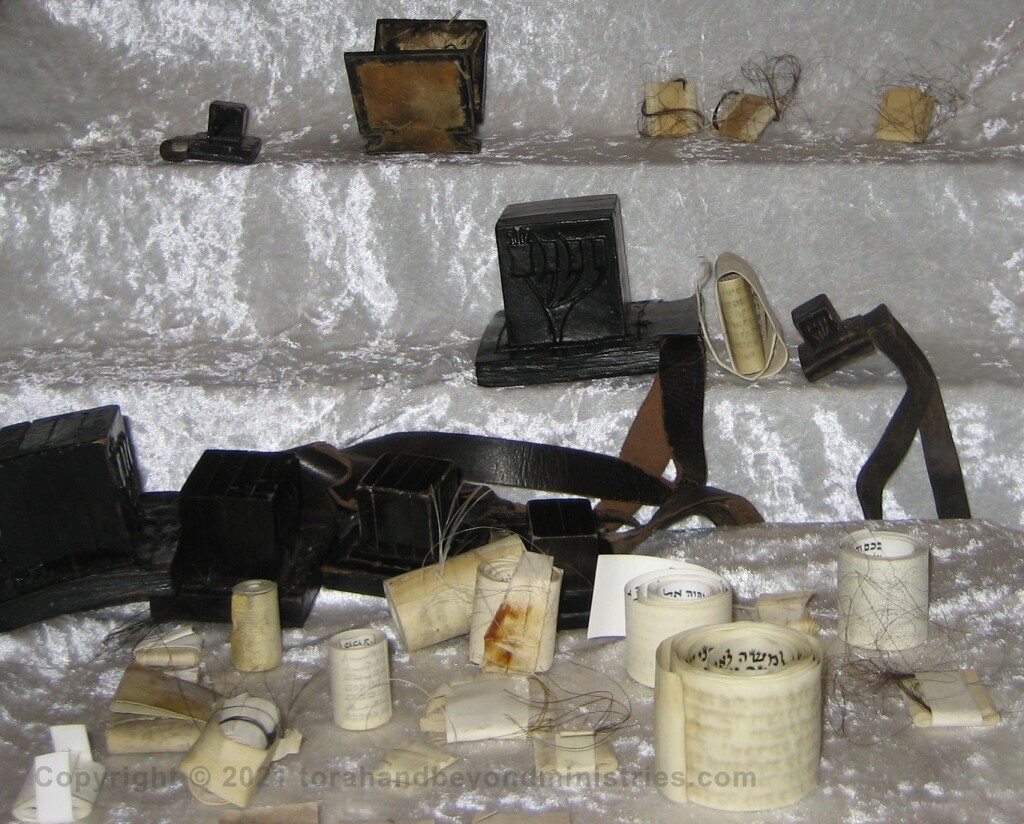
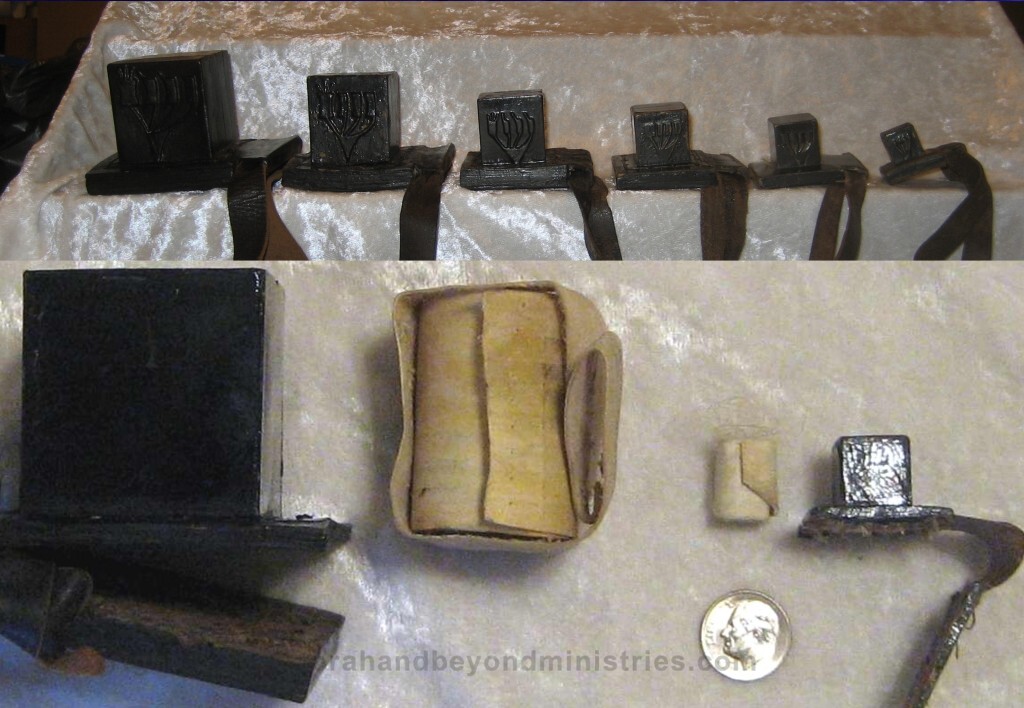
M – Mezuzah hzwzm
The Mezuzah is a small scroll containing verses from the Torah. The Scroll is usually rolled and put in a protective case then affixed to the doorpost of a Jewish home.
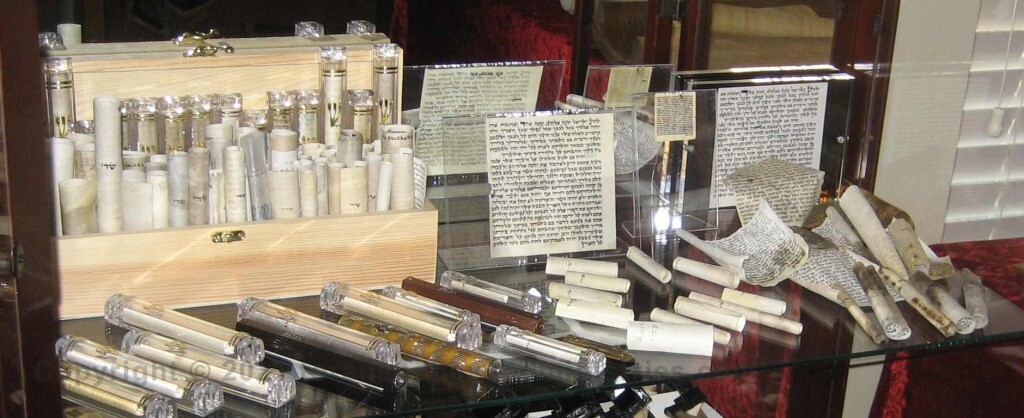
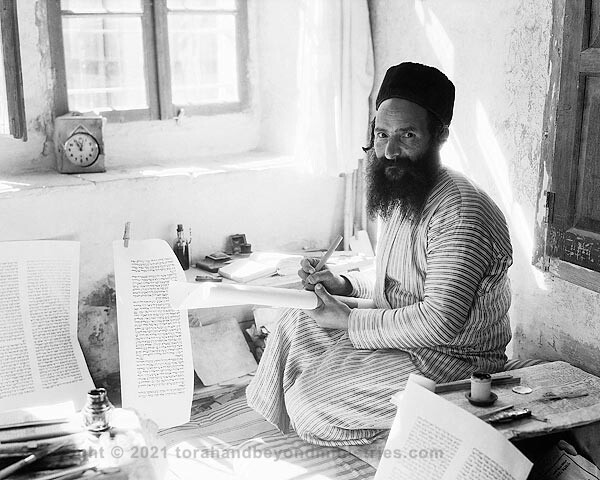
Yemenite Sofer
Why is it so important to keep a Biblical Hebrew Scroll from the Tanakh kosher?
Suppose a word is misspelled or a letter is not correct.
What difference does it make?
Noah xn
This is the Hebrew spelling of the one who built the ark to save mankind during the Flood. Suppose 3,000 years ago part of the first letter n (n) was damaged and the bottom of the letter could not be seen. The Hebrew word would then become:
Yich xy
We would all be telling the story of Yich and the Ark.
If the letters were not checked we would eventually have no hope of being sure we had the Word of God. That must not happen.
Jesus said in Matthew 5:18 For verily I say unto you, Till heaven and earth pass, one jot or one tittle shall in no wise pass from the law, till all be fulfilled.
What is a jot and a tittle? What was Jesus talking about?
First let’s discuss what it isn’t.
The jot and the tittle are not trope or accent marks.
Moses certainly did not use these.

Cantillation is the ritual chanting of readings from the Hebrew Bible in Synagogue services. The chants are written and notated in accordance with the special signs or marks printed in the Masoretic text of the Hebrew Bible (or Tanakh) to complement the letters and vowel points. Trope is the term for the notation system for chanting Torah. Trope are symbols for when to pause and where to stop in the Torah reading. They each have a different set of associated notes and when strung together become the chant for a given portion. The technical term for trope is Ta’amei haMikra, “the flavor of the reading.”It lets us know where our earlier ancestors thought the punctuation belongs since there isn’t any in the Torah scroll text itself.
The jot and tittle are not the vowel markings.
Moses certainly did not use these.

Around 600 A.D. a group of scribes in Tiberias called Masoretes began a system of vowel markings to indicate how the Hebrew text should be pronounced. The scribes did not want to altar the Word of God by adding letters so they placed markings under, to the left and on top of letters. These are the vowel markings.
The jot and tittle are not the taggin.
Moses certainly did not use these.
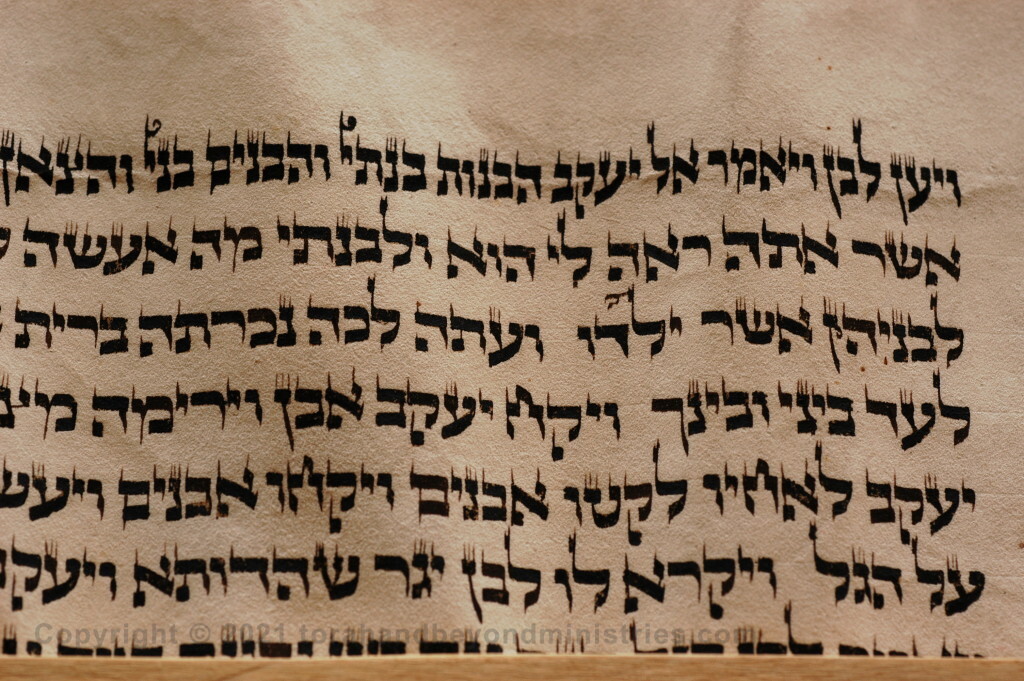
These little taggin are not part of the Hebrew letter and therefore do not add or take away from the letter. Three small vertical lines is the normal style for taggin. There are many opinions about where the Taggin came from, but the most prevalent view is the one summarized from the Talmud.
Before Moses wrote the Torah he was transported to Heaven to be shown how it must be done. He saw God writing a Torah and adding little lines to the top of some letters. Moses asked God why He was doing that and what they were. God said these lines they are daggers and arrows put here to protect My Word.
The jot and tittle are not the embellishing of letters.
Moses certainly did not use these.
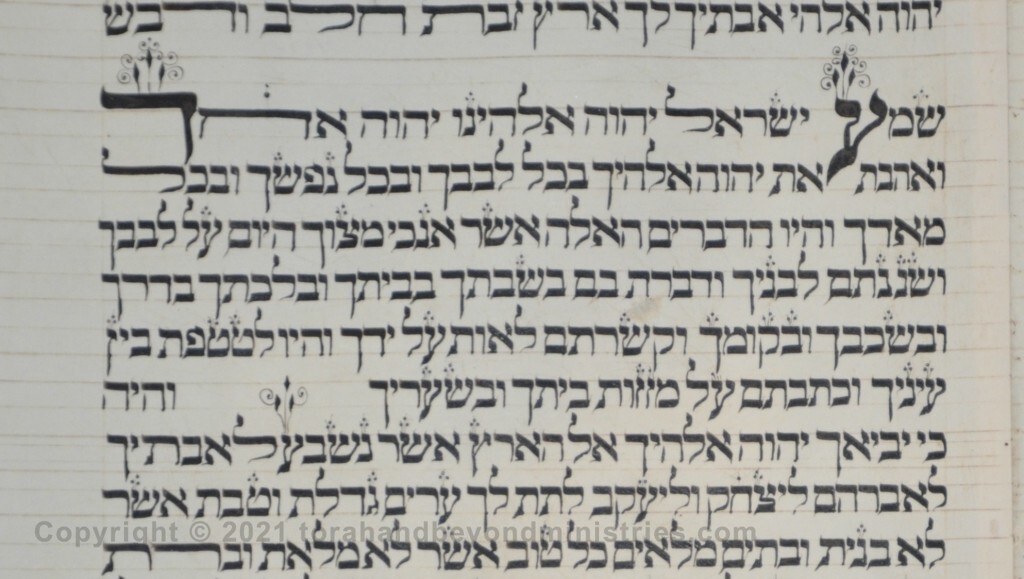
In a kosher scroll it is permissible to have a certain number of large letters, small letters, dots, inverted Nun, broken Vav, but the sofer may not go beyond the Halachic law or the scroll will be pasul. The scrolls from Yemen have the least number of “scribal oddities” and almost every scroll from Europe will have more than is permitted before the codification of Halachic law was enacted in the not too distant past.
So what are the jot and tittle? What choices do we have left?
Perhaps this is the answer.
Every letter of every word Moses wrote would be kept free from error.
When Jesus said one Jot or one Tittle would not pass from the Torah he was making reference to the Yod (JOT) the most common letter used 31,530 times in the Torah and the Tet (TITTLE) the least common letter used 1,802 times in the Torah.
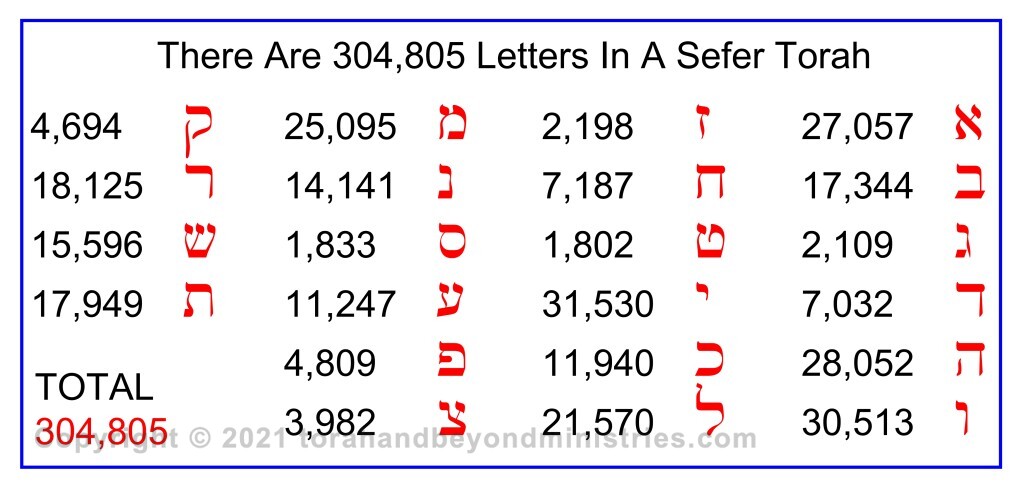
Accuracy is critical
The Jewish community is deeply concerned that the Torah says the same thing as the Scroll written by Moses. Over the millennia they have gone to great lengths to find the answer to that question.
Rabbi Dovid Lichtman wrote an excellent article on the subject and I will summarize his work as follows. According to the authorities in Halachah, and the opinions of RamBam, Vilna Gaon, Aharon ben Moshe ben Asher, the Torah is the most honored and prized possession of the Jewish nation. It is copied with such reverence that if one letter is added or subtracted from the writing, the Torah is considered pasul and can not be used until it is corrected. (Megilah 18b; YD #274) This creates a problem because all hand written manuscripts are subject to errors. Humans make mistakes. At least twice Torah scholars have gone on a world wide search throughout Jewish communities examining the pattern and accuracy of the Torahs in each region and then comparing all the regions of the world for consistency.
This is briefly the way they said the research was done. In each area, like Lithuania, Yemen, Morocco, Iraq, etc. five of the most highly revered Torah scrolls were examined as one group. Each letter was examined in the five scrolls and four of the five scrolls all had to come to 100% agreement in every single letter. Then the process was carried out in the next region. Finally one scroll was taken from each area of the world and they were compared among themselves for consistency.
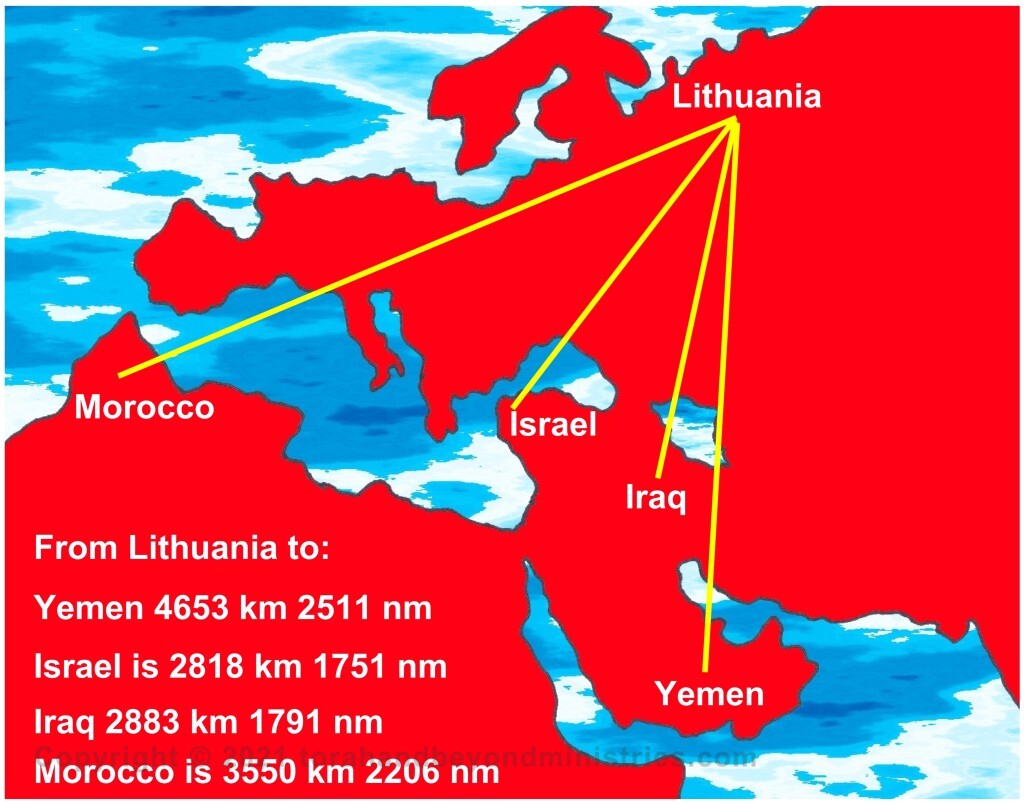
The final conclusion according to Rabbi Dovid Lichtman is that out of the 304,805 letters in the Torah there can be found only 6 letters in discrepancy between the Masoretic text and the original Torah written by Moses. These 6 letters are discrepancies of orthography, or proper spelling of each word. They do not change the meaning of the word. The 6 letters are the letter yod y and vav w. It was concluded that the Torah we have today, if they follow the Halachah laws will be .00004% accurate.
Scrolls from Yemen were overall considered to be the most consistent as a group. The reason given was the Yemenite Jewish community was so distant from the nearest neighbor that all the scrolls followed the same Tikkun guide. It was copied from the scroll known as “Ben Asher”. This scroll was written by Aharon ben Moshe ben Asher in the 10th century. It has been accepted as the most accurate scroll in existence and has been the standard for Halakha law. I have possessed two Sefer Torahs written in Yemen in the 1700s. When examining these scrolls in comparison to the scrolls coming out of Europe, I remember saying to myself, “This sofer took no kabalistic liberties in writing this scroll”. Every letter is written exactly perfect. There were absolutely no liberties taken or embellishment of a letter. This work on accuracy of the Torah is very interesting as written by Rabbi Dovid Lichtman.
torahcode.org/controversy/THE_ACCURACY_OF_OUR_WRITTEN_TORAH.pdf Rambam, Hil. Sefer Torah, beginning of 8:4
The Middle Letter
You might have heard that when a Torah is written it goes through a process of counting letters to pinpoint the “middle letter”. To find the truth about this I started a study that became so large and confusing I will at this point just offer my opinion, then briefly present a few areas to enter the study for yourself if you wish. (1), (2)
My opinion is that there had to be some control indicator that made it possible to know if the Torah was exactly the same as the original. I am just not sure how the Jews did such a good job for the last 3,500 years to have the world wide collection of Sefri Torahs in a .00004% agreement.
The Talmud in Kiddushim (30a) establishes that the accurate counting of the letters of the Torah was preserved at least until Tanaitic times 2nd century AD.
There is a saying, there is a middle letter in the Torah and that once the Torah is written the Sofer will start counting from the beginning of Genesis and 152,403 letters later will land at the spot of Leviticus 11:42 to the third letter of the word “gahon” (belly) and the letter will be Vav –w . Then the sofer will start at the back of the Torah and count forward 152,403 letters and will land on the exact letter Vav – w in Leviticus 14:42. This is called the Middle Letter of the Torah. Now the question is; did they do that?
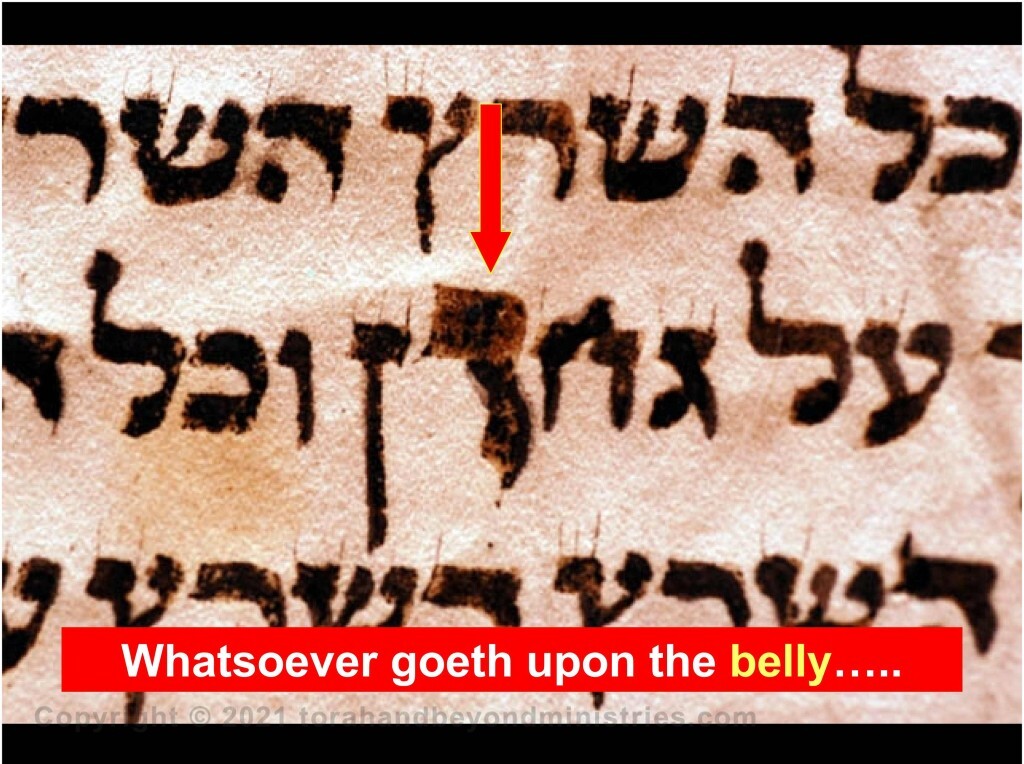
The word Sofer is the Hebrew word for “one who counts letters”. It is true that thousands of years ago a person was paid to write “letters” and he was paid according to the count or number of letters written.
Upon receiving my first Sefer Torah in 1999 and all subsequent Torah scrolls since, I have checked to see if this letter is marked by making it four times the size it is suppose to be. In all Torah scrolls the letter size is increased.
Over the years I have contacted several Soferim and rabbis to see what is said about the “Middle Letter of the Torah” and I have come to the conclusion that the saying is part true part rumor.
One sofer told me that many years ago the Soferim counted letters of the Torah but they forgot how and do not do it any longer. He said it was not just counting the number of letters because you could misspell many words if you had a letter to take the other letter’s place. He said he thought it was counting the numerical value of the letter. There are extensive papers you can read regarding this debated subject. The Talmud in Kiddushim (30a) establishes that the accurate counting of the letters of the Torah was preserved at least until the 2nd century AD.
